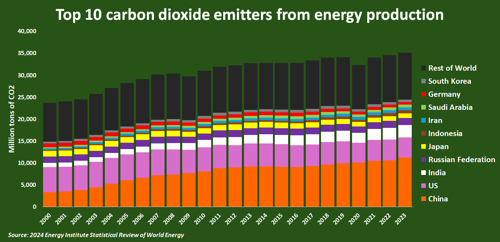Top 10 country emitters discharged record amounts of CO2 in 2023
The 10 largest country emitters of carbon dioxide (CO2) from energy production discharged a record 24.5 metric Bt of CO2 in 2023, according to the 2024 Energy Institute Statistical Review of World Energy.
That collective toll was 582 MMt (million tons) more than 2022's total, and came despite annual emissions cuts in five of the top 10 top polluters globally.

Big hitters. The three largest energy polluters were China, the U.S. and India, which together accounted for more than 53% of all energy pollution last year.
China alone discharged a record 11.2 Bt, which marked a 642 MMt jump in emissions from 2022, and its largest annual tonnage increase since 2011.
The emissions jump reflects the climb seen in China's industrial activity in 2023 from the year before, when a combination of fresh COVID-19 movement restrictions plus the onset of a construction sector credit crunch sapped economic activity.
China's output of construction steel and cement remains depressed, which is helping to keep emissions from heavy industry in check so far in 2024. But the manufacturing of other goods is showing signs of expansion, which should foster increased overall energy demand - and emissions - going forward.
India's emissions also scaled a new high of 2.8 Bt in 2023, which was up 219 MMt, or 8%, from 2022's total. India's energy sector emissions have grown by an average of 8% a year since 2021, compared to 3% growth in China over that period.
The country's reliance on coal for over 75% of its electricity generation means emissions trends will continue to rise for several more years, even as power firms build out more renewable generation capacity.
Emissions from the U.S. recorded a 158.5-MMt contraction in 2023 to 4.64 Bt, the lowest discharge from the energy sector since 2020 when COVID movement restrictions stifled refining activity and fuel demand.
As U.S. utilities are rolling out renewable generation capacity at a record pace while making further reductions to coal-fired power generation, additional emissions cuts from the U.S. power sector look likely over the remainder of this decade.
Big jumpers. Russia, Saudi Arabia and Iran all recorded annual rises in energy emissions in 2023.
Russia's 1.6 Bt of CO2 was the country's highest energy emissions toll since the mid-1990s, and marked the third successive year of pollution increases from the country.
Roughly 60% of Russia's power generation comes from fossil fuels, which the country is a major producer of.
Saudi Arabia recorded a third straight year of power sector emissions gains in 2023 to 620.4 MMt, although the 11-MMt rise in energy pollution was the country's smallest annual increase since it recorded a roughly 20-MMt fall in energy emissions in 2020.
Iran's energy emissions expanded by 6.5 MMt from 2022 to a new record of 683.6 MMt. As natural gas accounts for over 86% of Iran's electricity generation, further growth in national energy emissions are likely going forward.
The contractors. The U.S., Germany, Japan, South Korea and Indonesia all posted contractions in energy emissions in 2023.
Japan's energy pollution fell by 68.4 MMt to 1.01 Bt to the lowest level in more than 20 years, while South Korea's emissions fell nearly 22 MMt to a 13-year low of 571 MMt.
Germany's energy sector cut emissions by nearly 10% in 2023 to 572 MMt, the lowest on record.
An ongoing push to cut fossil fuel dependence and accelerate clean energy supply development look set to keep German emissions on a downward heading.
Indonesia's energy sector emissions registered a 3-MMt decline in 2023 from 2022's total, but the country looks set to keep emissions on a rising trajectory for the near term due to the country's high reliance on coal for power generation.
Coal generated a record 62% of the country's electricity in 2023, while natural gas generated an additional 18%, according to think tank Ember.
Such a high reliance on fossil fuels for power looks set to ensure that power producers in Indonesia, along with those in China and India, remain large power emitters despite ongoing efforts elsewhere to rein in energy pollution.
And as power emissions are also on a rising path within fast-growing neighbors such as Vietnam and the Philippines, total global energy sector pollution looks set to keep marching higher for the next several years.






Comments